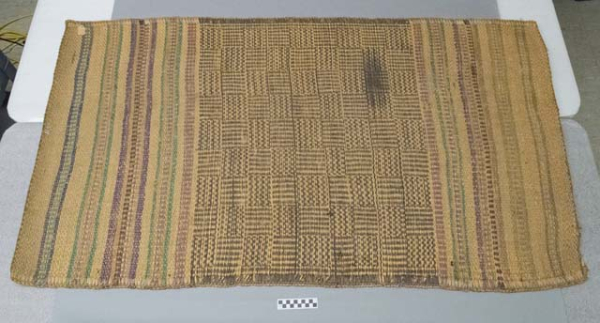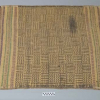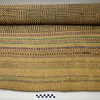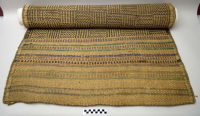naakan bullrush mat
naakan bullrush mat
naakan bullrush mat



This naakan bullrush mat, crafted around the 1880s, has a tan body with vertical ladder motifs and a central checkerboard grid featuring alternating horizontal rows in vibrant shades of yellow, green, indigo, and magenta. Originally one of five bullrush mats acquired by Harrington in 1905, a field collector for the Peabody Museum of Archaeology and Ethnography, this ancestor was purchased from Mrs. Eliza Rodd, wife of Albert Rodd (1827-1901), a member of the 1885 Indian Affairs, and grandson of Old Mother Rodd, known for her skill in crafting baskets and mats. According to Harrington's 1905 notes, this mat was crafted near Bay City, Michigan, at Saginaw, by Chippewa artisans. While Harrington's records suggest the use of artificial dyes due to the absence of mention of Indigenous dyes, the intricate color patterns and hints of faded yellows may indicate otherwise. Evidence of its use over 25 years is apparent in the heavy wear, along with the threadbare edges and a prominent black stain on the central motif. This ancestor is currently located in the Peabody Museum of Archaeology and Ethnography. In their records it is spelled nak-gun.
This rush mat is Sarnia made, as described by the Peabody Museum of Archaeology and Ethnography.
Information from this entry comes from John Devoy's essay titled "Bulrush Mats Purchased at Aamjiwnaang", student of Alan Corbiere at Harvard University, and The Peabody Museum of Archaeology and Ethnography's catalogue.
Read More About This Relative
Bullrush basswood. Artificial dyes?
"The Rodds were a notable local family who held the position of chief (in the person of Peter Rodd, 1907-1910) but are best known for their scion Old Mother Rodd [Figure 9], a local hero and subject of many stories. Old Mother Rodd died in 1870, but was universally recognized as having lived over 100 years, variously said to be between 104 and 118 at the time of her death, meaning she would have been born in the 1750s or 1760s. Her acquaintance Laura Farrand wrote a profile in 1890 which recalled that Old Mother Rodd was an artisan whose “baskets and mats were always well made” and that even after her hundredth birthday she would frequently canoe forty miles from Sarnia to the Swan Creek and Walpole Island reservations to see her friends" (John Devoy, 2023).
Old Mother Rodd married half French and half Ojibwa Alexander Rodd, known as “She-she-pe-anee” or “Little Duck”, and had Charlotte and Antoine, father of Albert Rodd, husband to Eliza Rodd.
Provenance
Harrington's 1905 log describes the mat as "Same, typical pattern, regular weave, has been in use 25 years. From Mrs. Eliza Rodd. Was made at Sagining near Bay City Mich by Chippewas"
The mat was purchased alongside five other mats, Harrington explains in a May 1905 letter to Putnam that the fourth mat was never sent because his wife “took an especial fancy to [it]” (Cf. Harvard Peabody Museum document collection, letter dated May 17th, 1905).
Dominion of Canada, Annual Report of the Department of Indian Affairs for the Year Ended 31st December, 1885, Ottawa: Maclean, Roger & Co., 1886, 17.
Laura Farrand, “Early History of St. Clair County, with Some Account of the Indians, Okemos, Macoonce, John Riley and Mothers Rodd and Obeidig, Chiefly from Original Sources,” in Collections and Researches Made by the Michigan Pioneer and Historical Society, Lansing: Robert Smith Printing Co., 1890, 437.
About This GRASAC Record
Unknown Maker. "Naakan bullrush mat", GKS ID 59161. Located at the Peabody Museum of Archaeology and Ethnography, catalogue number 05-19-10/65011
This record was created by Natasha Fares on February 26th, 2024. Information from this entry comes from John Devoy's essay titled "Bulrush Mats Purchased at Aamjiwnaang", student of Alan Corbiere at Harvard University, and The Peabody Museum of Archaeology and Ethnography's catalogue.













 Knowledge Sharing Platform
Knowledge Sharing Platform


